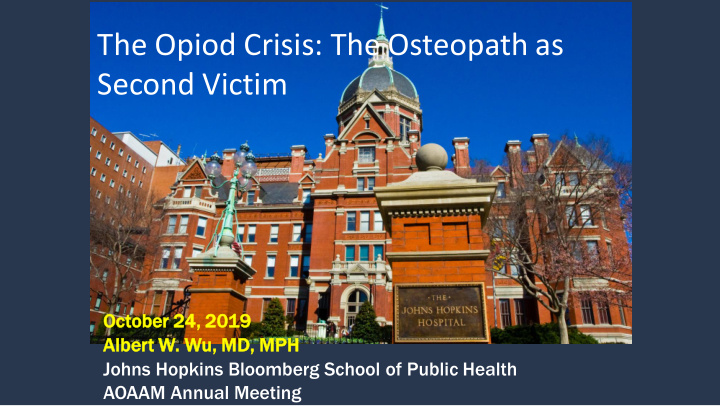



The Opiod Crisis: The Osteopath as Second Victim Octob tober r 24, 2019 Albert t W. Wu, MD, MPH Johns Hopkins Bloomberg School of Public Health AOAAM Annual Meeting
Disclosures • None 2
Objectives 1. Explain who are the “second victims” of patient adverse events 2. Explain the value of peer support to health care workers and health care organizations 3. Describe the RISE (Resilience in Stressful Events) peer support program
Conflicts of Interest • None to report
Case
Staff members are supported by my institution after an adverse event 1. Rarely 2. Occasionally 3. Sometimes 4. Most of the time 5. All of the time
Second Victim A health care provider involved in an unanticipated adverse patient event and/or medical error who is traumatized by the event
Natural History of the Second Victim (1) Clinician response to initial incident
Short and Longer Term Symptoms • Numbness, confusion • Detachment, depersonalization • Grief, depression, withdrawl • Anxiety, agitation • Sleep disturbance • Flashbacks, re-experiencing the event • Physical symptoms • Shame, guilt, self doubt • Impaired functioning
The Resilient Zone Model
Post Traumatic Stress Disorder (PTSD) - Re-experiencing the original trauma through flashbacks, nightmares - Avoidance of stimuli associated with the trauma - Increased arousal: difficulty falling or staying asleep, anger, hypervigilance - Symptoms lasting > one month
Peer Response
BMJ 2000
Natural History of the Second Victim (1) Initial response to incident (2) Peer response
What Would You Like S omeone to S ay to You?
Things People S ay Well, I wouldn’ t have done that Didn’ t you realize what would happen? What were you thinking? Why didn’ t you do x? Nothing (Things behind your back)
Natural History of the S econd Victim (1) Initial response to incident (2) Peer response (3) Investigation
Natural History of the S econd Victim (1)Initial response to incident (2) Peer response (3) Investigation (4) Malpractice suit
Multiple S econd Victim Traumas (2) Peer Response (1) 8 Adverse (3) Investigation Event (4) Litigation
Kimberly Hiatt Nurse Seattle, 2010 Medication error 5 yr old patient dies Dismissed from job Commits suicide http://www.vox.com/2016/3/15/11157552/medical-errors-stories-mistakes
Burnout When passionate, committed people become deeply disillusioned with a job from which they have previously derived much of their identity and meaning. It comes at the things that inspire passion and enthusiasm are stripped away and tedious or unpleasant things crowd in.
Burnout may contribute to Emotional exhaustion loss Eroded professionalism of enthusiasm for work Compromised quality of care Depersonalization feeling cynicism, treating people Increased risk for medical as objects errors Early retirement Low sense of personal Addiction & accomplishment suicidal ideation feeling ineffective at work This is burnout
Burnout by Specialty Shanafelt Arch Intern Med 2012:172:1377
Staff members perceive asking for help as being “weak” 1. Agree strongly 2. Agree somewhat 3. Unsure 4. Disagree somewhat 5. Disagree strongly
75% wanted prompt debriefing for individual or group/team)
RISE “ Safe ” and Confidential – no report back, notification, investigation 24/7 on call support (online or page) Call back within 30 minutes One to one or group support by peers Psychological First Aid
R.I.S.E. Resilience In Stressful Events “Provide timely support to employees who encounter stressful, patient- related events” Pager: 410-283-3953
Psychological First Aid (PFA) Guide for Field Workers WHO publication: www.who.int Collaborative effort: – World Health Organization – War Trauma Foundation – World Vision International Endorsed by 24 UN/NGO international agencies Available in several languages
Continuum of Care
The RISE team
Add Modern Healthcare • http://www.modernhealthcare.com/article/20180131/NEWS/ 180139979 •
Cost Benefit Analysis of RISE • RISE costs money up-front to implement • Cost of Nurse • Time off = $211 per day • Quitting = $100,000 • The cost-benefit of RISE within 1- year, i.e. a positive “net monetary benefit (NMB)” of $22,576 per call • Additional savings from improved safety+quality Moran, Wu, Connors, Chappidii, Sreedhara, Selter, Padula. J Patient Safety in press
Presented by Maryland Patient Safety Center in collaboration with The Johns Hopkins Hospital RISE Program
A Fourth Aim of Health Care? • Enhance patient experience of care • Improve the health of populations • Reducing the per capita cost of health care • Maintain well being of the health care team • Bodenheimer, Ann Fam Med 2014
Health care depends on healthy doctors and nurses Care of the patient requires care of the provider
Journal of Patient Safety and Risk Management Please submit your papers! Peer-reviewed journal print+online that provides international forum for new knowledge+ideas in patient safety, risk management and medico-legal. Prioritizes evidence-based research, reviews, commentary, cases on patient safety issues with implications for patient care, clinical and professional practice, health care governance and policy https://mc.manuscriptcentral.com/jpsrm Albert W. Wu, MD, MPH, Editor-in-Chief Awu@jhu.edu @withyouDrWu http://journals.sagepub.com/home/cri
Education and Training https://www.jhsph.edu/academics/online-learning-and-courses/online- programs/online-programs-for-applied-learning/master-of-applied-science-patient- safety-and-healthcare-quality/index.html 40
www.josieking.org
awu@jhu.edu @withyouDrWu
Some Resources Wu, AW. Medical Error: The Second Victim. The Doctor Who Makes the Mistake Needs Help Too. BMJ 2000 320:726-727 Wu AW, Steckelberg RC. Medical error, incident investigation and the second victim: doing better but feeling worse? BMJ Qual Saf. 2012 Apr;21(4):267-70 Scott SD, Hirschinger LE, Cox KR, McCoig M, Brandt J, Hall LW. The natural history of recovery for the healthcare provider "second victim" after adverse patient events. Qual Saf Health Care. 2009 Oct;18(5):325-30 de Wit ME, Marks CM, Natterman JP, Wu AW. Supporting second victims of patient safety events: shouldn't these communications be covered by legal privilege? J Law Med Ethics. 2013 Winter;41(4):852-8 Edrees H, Connors C, Paine L, Norvell M, Taylor H, Wu AW. Implementing the RISE second victim support programme at the Johns Hopkins Hospital: a case study. BMJ Open. 2016 Sep 30;6(9):e011708 Moran D, Wu AW, Connors C, Chappidi MR, Sreedhara SK, Selter JH, Padula WV. Cost-Benefit Analysis of a Support Program for Nursing Staff. J Patient Saf. 2017 Apr 27
Recommend
More recommend